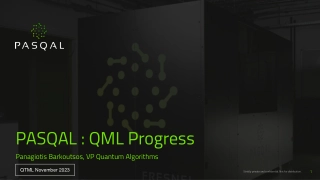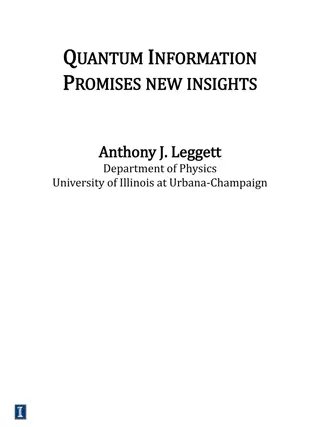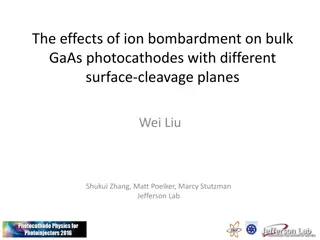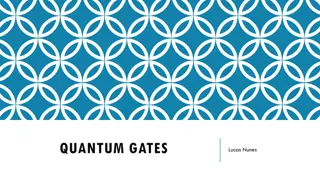Universal Two-Qubit Computational Register for Trapped Ion Quantum Processors
Universal two-qubit computational register for trapped ion quantum processors, including state preparation, gates, and benchmarking. The experimental setup and results are discussed.
Download Presentation

Please find below an Image/Link to download the presentation.
The content on the website is provided AS IS for your information and personal use only. It may not be sold, licensed, or shared on other websites without obtaining consent from the author.If you encounter any issues during the download, it is possible that the publisher has removed the file from their server.
You are allowed to download the files provided on this website for personal or commercial use, subject to the condition that they are used lawfully. All files are the property of their respective owners.
The content on the website is provided AS IS for your information and personal use only. It may not be sold, licensed, or shared on other websites without obtaining consent from the author.
E N D
Presentation Transcript
A universal two A universal two- -qubit computational register for computational register for trapped trapped- -ion quantum processors ion quantum processors qubit Nicolas Pulido-Mateo1,2, Hardik Mendpara1,2, Markus Duwe1,2, Giorgio Zarantonello1,3, Amado Bautista-Salvador1,2,3, Ludwig Krinner1,2and Christian Ospelkaus1,2,3 1Institut f r Quantenoptik, Leibniz Universit t Hannover, Welfengarten 1, 30167 Hannover 2PTB, Bundesallee 100, 38116 Braunschweig 3QUDORA Technologies GmbH, Wilhelmsgarten 3, 38100 Braunschweig
https://www.qvls-q1.de Motivation QVLS-Q1 Trapped-ion based QCCD architecture Surface-electrode trap Multizone: Trapping Storage State preparation and readout Computation Characterization and benchmarking Universal set of gates Two-qubit entangling gate Single-qubit rotations D. Wineland et al., J. Res. NIST 103 (1998) D. Kielpinski et al., Nature 417 (2002)
Outline Experimental setup Two-qubit entangling gates Single-qubit rotations Cycle Benchmarking experiment Discussion
Beryllium: State preparation Physical sequence: State initialization in |2,2 Doppler cooling Microwave hop to |1 Ground-state cooling Microwave hop to |0
Microwave near-field I (?) Transition Speed Scaling ? ? 1 Carrier ? ? ? 2 Sidebands ? ? ? 3 2nd Sidebands ? ++ + ? ? 4 3rd Sidebands ? d ? ? ? Microwave conductor I (?) Impact of residual B-field: AC Zeeman shift (gate-error) 5
Microwave near-field engineering + d MWM excitation Embedded single microwave conductor in surface-electrode ion trap Single conductor intrinsically phase and amplitude stable Geometry can be optimized to suppress residual field M. Carsjens et al., Appl. Phys. B 114, 423-250 (2014)
Mlmer-Srensen gate Klaus M lmer and Anders S rensen Phys. Rev. Lett. 82 (1999)
Mlmer-Srensen gate: Fidelity analysis scan Sackett et al., Nature 404, (2000) Hahn et al., npj Quantum Inf 5, 70 (2019) Effect Infidelity 1.3 10-2 Mode instability 5.2 10-3 Spectator mode 3.8 10-3 Motional heating
Mlmer-Srensen gate: Pulse shaping M Duwe et al 2022 Quantum Sci. Technol. 7 045005 Zarantonello et al., PRL, 123, (2019)
Single-ion addressing Rotate ion crystal Displace ion to be addressed out of micromotion minimum Micromotion sideband interaction Qubit 1 Qubit 2 + + x Trap center U. Warring et al., PRL 110, 173002 (2013) D. Leibfried PRA 60, R3335(R), (1999)
Single-ion addressing: Flopping and crosstalk scan t Piltz et al., Nat Commun 5, 4679 (2014) ion0= 2 11.145(5) kHz ion1= 2 5.655(5) kHz
Simple circuits: Cycle benchmarking repeat mj times Erhard et al., Nat Commun 10, 5347 (2019)
Discussion Why 96.6 % fidelity? Calibration errors M e / etu i g We are robust AC Zeeman shift Need order of magnitude more Phase (principal suspect) Offset between 1 and 2-qubit gates Frame of reference 10o per circuit?
Acknowledgments Thanks to my colleagues: Hardik Mendpara, Markus Duwe, Christian Joohs a.k.a. CJ, Alexander Onkes, Yannick Hermann, Giorgio Zarantonello, Amado Bautista- Salvador, Ludwig Krinner, Christian Ospelkaus, Thanks to the Alumni: M. Wahnschaffe, H. H h , We greatly acknowledge all of our third-party funding























